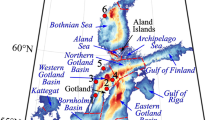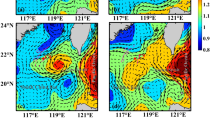Summary
The winter of 1996/97 can be characterized as moderate in the western and central Baltic Sea but was only weak in the Gulfs of Bothnia, Finland and Riga. The temperatures in the winter surface and summer intermediate layers met the long-term mean. The summer of 1997 was the warmest since 1890. Water temperatures reached positive anomalies up to 6 K in the 10 m upper layer due to sunny weather conditions and weak winds during August.
The meteorological conditions in 1997 did not give rise to major Baltic inflows. Between the end of May and the beginning of November, persistent inflow was recorded in the near-bottom layers of Darss Sill which culminated in two storms in September and at the beginning of October transporting larger volumes of exceptionally warm and saline water across the sills into the Baltic. This led to positive temperature anomalies of 3-4 K in the Bornholm Basin deep water. The basin was filled at depths >60 m by water with salinities >15 PSU, and at the end of October warm (9-11δC), saline (14-15 PSU) and oxygen-rich water (up to 2.5 cm3/dm3) crossed the Stolpe Sill into the central Baltic Sea. Small inflows shortly interrupted the stagnation of the deep water in the Gotland and Färö Deeps between February and May 1997. From August onward the layer below 150 m in the eastern Gotland Basin again became anoxic. The deep water of the western Gotland Basin continues to be oxic. The decreasing phosphate concentrations measured in the mixed winter surface layer for several years continued in all Baltic areas of investigation. The winter concentrations of nitrate are still high but in 1997 first signs of a decrease were observed.
Significant impacts of the exceptional Oder flood in summer 1997 were only observed in the Pomeranian Bight. The measured concentrations of most of the inorganic nutrients were in the same range as those observed earlier during periods of increased Oder discharges in spring. Significantly increased concentrations were, however, measured for silicate and organic carbon and nitrogen compounds. In August, hydrogen sulphide occurred in the bottom layer off Usedom island. Long-term effects of the nutrient load on the ecosystem in the Pomeranian Bight and in the entire Baltic Sea are not to be expected.
Zusammenfassung
Der Winter 1996/97 kann in der westlichen und zentralen Ostsee als mäβig, im Bottnischen, Finnischen und Rigaer Meerbusen aber nur als schwach charakterisiert werden. Dementsprechend lagen die Temperaturen im winterlichen Oberflächenwasser weitgehend im normalen Bereich. Der Sommer 1997 war dagegen auβergewöhnlich warm und muβ als der wärmste seit 1890 angesehen werden. Die sommerlichen Wassertemperaturen erreichten in einer 10 m mächtigen Deckschicht positive Anomalien bis zu 6 K. Im Jahre 1997 erfolgte kein Salzwassereinbruch. In der grundnahen Schicht herrschte im Bereich der Darβer Schwelle von Ende Mai bis Anfang November anhaltender Einstrom, der während der Sturmereignisse im September und Anfang Oktober gröβere Mengen sehr warmen und salzreichen Wassers öber die Schwellen in die Ostsee transportierte. Das führte im Tiefenwasser des Bornholmbeckens zu positiven Temperaturanomalien von 3-4 K. Das gesamte Becken war ab Tiefen gröβer als 60 m mit salzreichem Wasser >15 PSU gefüllt und Ende Oktober floβ warmes (9-11 °C), salz- (14-15 PSU) und sauerstoffreiches Wasser (bis 2,5 cm3/dm3) ungehindert über die Stolper Schwelle in die zentrale Ostsee ab. Die Stagnation im Tiefenwasser des Gotland- und Färötiefs wurde von Februar bis Mai 1997 kurzzeitig durch Einstromprozesse unterbrochen. Jedoch bereits ab August 1997 waren die Tiefenbereiche des östlichen Gotlandbeckens unterhalb von etwa 150 m wieder mit schwefelwasserstoffhaltigem Wasser gefüllt. Wie in den Vorjahren wurde auch 1997 im westlichen Gotlandbecken kein Schwefelwasserstoff gemessen. Bei den Winterkonzentrationen der anorganischen Nährstoffe setzte sich die bereits in den Vorjahren erkennbare Entwicklung fort. Beim Phosphat zeigte sich eine weiterhin abnehmende Tendenz in allen untersuchten Seegebieten. Bei den Nitratkonzentrationen, die nach wie vor hoch sind, wurden 1997 erste Anzeichen für einen leichten Rückgang beobachtet, wenngleich die Tendenz noch nicht so ausgeprägt ist wie beim Phosphat.
Signifikante Auswirkungen des Sommerhochwassers der Oder auf die Ostsee waren im wesentlichen nur in der Pommerschen Bucht zu beobachten. Die gemessenen Konzentrationen der meisten anorganischen Nährstoffe waren in der gleichen Gröβenordnung, wie sie bei früheren Untersuchungen zu Zeiten verstärkten Oderausstroms im Frühjahr zu beobachten waren. Signifikant erhöhte Konzentrationen wurden aber für Silikat sowie für organische Kohlenstoff- und Stickstoffverbindungen gefunden. Im Bereich der Ausstromfahne der Oder vor Usedom kam es im August zur Bildung von Schwefelwasserstoff in den bodennahen Schichten. Langzeiteffekte der während des Hochwassers eingetragenen Nährstoffmengen auf das Ökosystem sind weder für die Pommersche Bucht noch für die Ostsee zu erwarten.
Similar content being viewed by others
References
Bergström, S. andB. Carlsson, 1994: River runoff to the Baltic Sea: 1950-1990.Ambio,23, 280–287.
Bergström, S. andW. Matthäus, 1996: Meteorology, hydrology and hydrography. In: Third periodic assessment of the state of the marine environment of the Baltic Sea, 1989-1993; Background Document.Baltic Sea Environ. Proc,64B, 9–18.
v. Bodungen, B., M. Graeve, J. Kube, H. U. Lass, B. Meyer-Harms, N. Mumm, K. Nagel, F. Pollehne, M. Powilleit, M. Reckermann, C. Sattler, H. Siegel andD. Wodarg, 1995: Stoff-Flüsse am Grenzfluβ-Transport-und Umsatz-Prozesse im Übergangsgebiet zwischen Oderästuar und Pommerscher Bucht (TRUMP).Geowiss.,13, 479–485.
DWD, 1997: Monatlicher Witterungsbericht. Deutscher Wetterdienst, Offenbach,45, No. 1-13.
Fitzwater, S. E. andJ. H. Martin, 1993: Notes on the JGOFS North Atlantic Bloom Experiment dissolved organic carbon intercomparison.Mar. Chem.,41, 179–185.
Fonselius, S. H., 1977: An inflow of unusually warm water into the Baltic deep basins.Medd. Havsfiskelab. Lysekil, Hydrogr. avdeln.,229, 1–15.
Franck, H., 1985: Zur jahreszeitlichen Variation des thermohalinen Geschehens im westlichen Bornholmbekken.Beitr. Meereskunde,53, 3–16.
Fuchs, T. andJ. Rapp, 1997: Zwei auβergewöhnlich starke Regenepisoden als Ursache des Oderhochwassers im Juli 1997. Beilage zurWetterkarte des DWD, 158/1997:1–4.
Helcom, 1988: Guidelines for the Baltic Monitoring Programme for the third stage.Baltic Sea Environ. Proc,27, Part A, Introductory chapters, 1-49; PartB, Physical and chemical determinants in sea water, 1–60.
Helcom, 1996: Third periodic assessment of the state of the marine environment of the Baltic Sea, 1989-1993; Background Document.Baltic Sea Environ. Proc,64B, 1–252.
Humborg, C, G. Nausch, T. Neumann, F. Pollehne ANDN. Wasmund, 1998: The exceptional Oder flood in summer 1997 — the fate of nutrients and particulate organic matter in the Baltic Sea.Dt Hydrogr. Z,50, 2/3 (in press.).
Jakobsen, F., 1996: The dense water exchange of the Bornholm Basin in the Baltic Sea.Dt. Hydrogr. Z,48, 161–174.
Kõuts, T. andA. Omstedt, 1993: Deep water exchange in the Baltic Proper.Tellus,45A, 311–324.
Krauss, W. andB. Brügge, 1991: Wind-produced water exchange between the deep basins of the Baltic Sea.J. Phys. Oceanogr.,21, 373–384.
Krüger, S., W. Roeder andK.-P. Wlost, 1996: The IOW Baltic stations Darss Sill and Oder-Bank — part of the German Marine Monitoring Network — MARUM. Baltic Marine Science Conference, Rønne, October 1996. In:ICES Mar. Sci. Symp. (in press).
Krüger, S., W. Roeder, K.-P. Wlost, M. Koch, H. Kämmerer andT. Knutz, 1998: Autonomous instrumentation carrier (APIC) with acoustic transmission for shallow water profiling. Oceanology International 98: The Global Ocean.Conf. Proc,2, 149–158.
Lass, H. U., R. Schwabe, W. Matthäus andE. Francke, 1987: On the dynamics of water exchange between Baltic and North Sea.Beitr. Meereskunde,56, 27–49.
Laun, 1997a: 3. Bericht zu den Auswirkungen des Oder-Hochwassers auf das Kleine Haff und die Pommersche Bucht (Zeitraum 07. 08.-13. 08. 1997). Landesamt für Umwelt und Natur Mecklenburg-Vorpommern, Stralsund, 15. 8. 1997, 1–9.
Laun, 1997b: 4. Bericht zu den Auswirkungen des Oder-Hochwassers auf das Kleine Haff und die Pommersche Bucht (Zeitraum 14. 08.-25. 08. 1997). Landesamt für Umwelt und Natur Mecklenburg-Vorpommern, Stralsund, 29. 8. 1997, 1–8.
Laun, 1998: Gewässergütebericht 1996/97 —Oberirdische Gewässer, Küstengewässer und Grundwasser. Hrsg.: Ministerium für Bau, Landesentwicklung und Umwelt Mecklenburg-Vorpommern. Schwerin.
Lenz, W., 1971: Monatskarten der Temperatur der Ostsee.Dt Hydrogr. Z, Erg.-H. B,11, 1–148.
Lintrup, M. J. and F. Jakobsen, 1998: The importance of øresund and the Drodgen Sill for major Baltic inflows.J. Mar. Systems (in press).
Lundqvist, J.-E. andI. Asp, 1997: A summary of the ice season and icebreaking activities 1996/97. SMHI-Sjöfartsverket, Norrköping 1997, 1–49.
Matthäus, W., 1975: Mittlere Temperaturund Sauerstoffverhältnisse in der Arkonasee am Beispiel der Station BY 2A auf 55° N, 14° E.Beitr. Meereskunde,36, 5–27.
Matthäus, W., 1977: Zur mittleren jahreszeitlichen Veränderlichkeit der Temperatur in der offenen Ostsee.Beitr. Meereskunde,40, 117–155.
Matthäus, W., M. Sturm andE. Francke, 1976: Einige Aspekte des thermischen Regimes der Ostsee im Sommer 1975 am Beispiel der Bornholmsee.Z Meteorol.,26, 360–372.
Matthäus, W., D. Nehring, H. U. Lass, G. Nausch, K. Nagel andH. Siegel, 1996: The Baltic Sea in 1996 continuation of Stagnation and decreasing phosphate concentrations.Dt. Hydrogr. Z,48, 161–174.
Matthäus, W., D. Nehring, H. U. Lass, G. Nausch, K. Nagel andH. Siegel, 1997: Hydrographisch-chemische Zustandseinsch↦zung der Ostsee 1996.Meereswiss. Ber. Warnemünde,24, 1–49.
Matthäus, W., G. Nausch, H. U. Lass, K. Nagel andH. Siegel, 1998: Hydrographisch-chemische Zustandseinschätzung der Ostsee 1997.Meereswiss. Ber. Warnemünde,29, 1–65.
Mohrholz, V. andH. U. Lass, 1998: Transports between Oderhaff and Pomeranian Bight — a simple barotropic box model.Dt. Hydrogr. Z, (in press).
Mohrholz, V., M. Pastuszak, S. Sitek, K. Nagel andH. U. Lass, 1998: The exceptional Oder flood in summer 1997 — riverine mass and nutrient transport into the Pomeranian Bight.Dt. Hydrogr. Z,50, 2/3 (in press).
Nausch, G. andD. Nehring, 1994: Nutrient dynamics in the Gotland Deep reactions to the major salt water inflow in 1993. Proc. 19th Conf. Baltic Oceanographers, Sopot 1994, 2, 551–559.
Nausch, G., D. Nehring andG.Ærtebjerg, 1998: Anthropogenic nutrient load of the Baltic Sea.Limnologica (in press).
Nehring, D. andW. Matthäus, 1991: Current trends in hydrographic and chemical parameters and eutrophication in the Baltic Sea.Int. Revue ges. Hydrobiol.,76, 297–316.
Nehring, D., W. Matthäus andH. U. Lass, 1993: Die hydrographisch-chemischen Bedingungen in der westlichen und zentralen Ostsee im Jahre 1992.Dt. Hydrogr.Z,45, 281–312.
Nehring, D., W. Matthäus, H. U. Lass, G. Nausch andK. Nagel, 1995a: Hydrographisch-chemische Zustandseinschätzung der Ostsee 1994.Meereswiss. Ber. Warnemünde,9, 1–71.
Nehring, D., W. Matthäus, H. U. Lass, G. Nausch andK. Nagel, 1995b: The Baltic Sea in 1995 beginning of a new stagnation period in its central Baltic deep waters and decreasing nutrient load in its surface layer.Dt. Hydrogr. Z,47, 319–327.
Pastuszak, M., S. Sitek andA. Grelowski, 1998: Nutrient concentrations in the Swina Strait during the years 1996 and 1997 with emphasis on the flood event.Dt. Hydrogr. Z,50, 2/3 (in press).
Siegel, H., M. Gerth andT. Schmidt, 1996: Water exchange in the Pomeranian Bight investigated by satellite data and shipborne measurements.Cont. Shelf Res.,16, 1793–1817.
Siegel, H., M. Gerth, R. Tiesel andG. Tschersich, 1998a: Seasonal and interannual variations in sea surface temperature of the Baltic Sea from 1990-1997.Dt. Hydrogr. Z (in preparation).
Siegel, H., W. Matthäus, R. Bruhn, M. Gerth, G. Nausch, T. Neumann andC. Pohl, 1998b: The exceptional Oder flood in summer 1997 distribution patterns of the Oder discharge in the Pomeranian Bight.Dt. Hydrogr. Z,50, 2/3(in press).
SMHI, 1997: Ice conditions and sea surface temperatures. Maps No. 1-102, Norrköping.
Strübing, K., 1996: The ice winter of 1996/97 on the German coasts between Ems and Oder, with a survey of the entire Baltic area.Dt. Hydrogr. Z,48, 185–195.
Tiesel, R., 1998: Temperatursummen der Lufttemperaturen an der Wetterstation Warnemünde 1946–1997. Deutscher Wetterdienst, Wetterstation Warnemünde (unpubl.).
Wasmund, N., G. Nausch andW. Matthäus, 1998: Phytoplankton spring blooms in the southern Baltic Sea spatio-temporal development and long-term trends.J. Plankton Res.,20, 1099–1117.
Westphal, H., W. Rosenthal, W. Buchholtz, C. Fenske andA. Bachor, 1998: Biogeochemical investigations in the Szczecin Lagoon in the period of the Odra flood in July and August 1997.Dt. Hydrogr. Z,50, 2/3 (in press).
Author information
Authors and Affiliations
Rights and permissions
About this article
Cite this article
Matthäus, W., Nausch, G., Lass, H.U. et al. The baltic sea in 1997-impacts of the extremely warm summer and of the exceptional oder flood. Deutsche Hydrographische Zeitschrift 50, 47–69 (1998). https://doi.org/10.1007/BF02764476
Received:
Accepted:
Published:
Issue Date:
DOI: https://doi.org/10.1007/BF02764476




